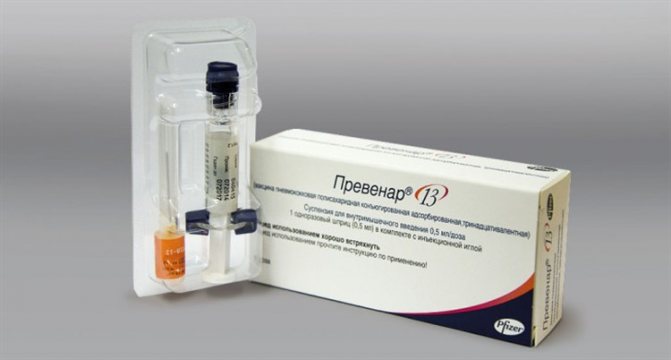Streptococcal infection is a group of microorganisms that are causative agents of a huge number of inflammatory diseases that occur with severe intoxication, dysfunction of internal organs and are often accompanied by complications.
The most susceptible to streptococci are children in the first years of life, whose immune system is not strong enough to fully resist bacterial agents. That is why young patients need additional protection against streptococci, represented by vaccination against a group of diseases associated with these pathological pathogens.
Vaccination against streptococci (pneumococci) is now included in the National Vaccination Calendar and allows you to protect the child’s body from a number of serious pathologies, in particular pneumonia, acute bronchitis, meningitis, as well as otitis media and inflammation of the joints.
Indications and contraindications for vaccination
Immunoprophylaxis of streptococcal infection is indicated for patients of all age categories to prevent the development of diseases etiologically associated with damage to the body by the pathogenic flora of the same name.
First of all, doctors recommend vaccination for young children who:
- there are frequent contacts with a large number of small children (being in a kindergarten or other children's group);
- the immune system is weakened as a result of the presence of chronic diseases, immunodeficiency conditions, anemia, diabetes mellitus, etc.
You should refuse vaccination in the following cases:
- the patient has an individual intolerance to the components of the vaccine;
- presence in the anamnesis of information about the development of an allergic reaction to a previous vaccination against streptococci (pneumococci);
- acute variant of the course of infectious diseases of viral and bacterial origin with an increase in general body temperature, intoxication, catarrhal manifestations, etc.;
- hidden inflammatory processes in the body, confirmed by a blood test done on the eve of the procedure;
- exacerbation of chronic pathologies.
Ignoring the presence of contraindications to vaccination in a patient can result in serious consequences with the development of severe pathological conditions and even the death of a child or adult.
The most popular beta-hemolytic streptococci include:
Serogroup A (GAS): Streptococcus pyogenes (formerly Streptococcus haemolyticus), Streptococcus agalactiae anginosus, S. dysgalactiae subsp. Equisimilis. This group of streptococci usually contributes to the development of a large number of diseases throughout the body - tonsillitis, pharyngitis, pyoderma, scarlet fever, vaginitis, cystitis, cervicitis, endometritis and others.
Serogroup B (GBS): Streptococcus agalactiae. This group of streptococci usually settles in the intestines and genitourinary system. They contribute to the development of various infectious diseases of newborns and women in labor - endometritis, meningitis, sepsis, neurological disorders and others.
Serogroup C (GCS): Streptococcus equi, Streptococcus zooepidemicus. They are pathogenic microflora that infect animals and cause disease in animals.
Serogroup D (GDS): Streptococcus faecalis, Streptococcus faecies. Promote the development of septic processes. These types of bacteria were transferred to another family - enterococci (lat. Enterococcus).
Diagnosis of streptococcus
A test for streptococcus is usually taken from the following materials: swabs taken from the oropharynx (for diseases of the upper respiratory tract), vagina or urethra (for diseases of the genitourinary system), sputum from the nose, scrapings of the surface of the skin (for erysipelas), as well as blood and urine .
Thus, the following tests and methods for examining the body for streptococcal infection are distinguished:
- General blood and urine analysis;
- Biochemical analysis of blood and urine;
- Bacteriological culture of sputum and smears taken from the nasal cavity and oropharynx;
- Ultrasound of internal organs;
- X-ray of the lungs;
- Electrocardiography.
In addition, differential diagnosis is necessary to distinguish streptococcal infection from: diphtheria, infectious mononucleosis, rubella, measles, dermatitis, eczema and other types of infection - staphylococcus, trichomonas, gerdnerella, candida, chlamydia, ureaplasma, mycoplasma, etc.
Treatment of streptococcus
How to treat streptococcus? Treatment for streptococcus usually consists of several points:
1. Antibacterial therapy; 2. Strengthening the immune system; 3. Restoration of normal intestinal microflora, which is usually disrupted when using antibacterial drugs; 4. Detoxification of the body; 5. Antihistamines - prescribed to children with allergies to antibiotics; 6. Symptomatic therapy; 7. If there are other diseases at the same time, they are also treated.
The beginning of treatment is a mandatory visit to a doctor, who, using diagnostics, will identify the type of pathogen and an effective remedy against it. The use of broad-spectrum antibiotics can worsen the course of the disease.
Treatment of streptococcal infection can be carried out by different specialists - depending on the form of infection - therapist, pediatrician, dermatologist, gynecologist, surgeon, urologist, pulmonologist, etc.
1. Antibacterial therapy
Important! Before using antibiotics, be sure to consult your doctor.
Antibiotics against streptococci for internal use: Azithromycin, Amoxicillin, Ampicillin, Augmentin, Benzylpenicillin, Vancomycin, Josamycin, Doxycycline, Clarithomycin, Levofloxacin, Midecamycin , "Roxithromycin", "Spiramycin", "Phenoxymethylpenicillin", "Cefixime", "Ceftazidime", "Ceftriaxone", "Cefotaxime", "Cefuroxime", "Erythromycin".
The course of antibacterial therapy is prescribed individually by the attending physician. Usually it is 5-10 days.
Antibiotics against streptococci for topical use: “Bioparox”, “Hexoral”, “Dichlorobenzene alcohol”, “Ingalipt”, “Tonsilgon N”, “Chlorhexidine”, “Cetylpyridine”.
Important! Antibacterial drugs of the penicillin series are widely used to treat streptococci. If allergic reactions to penicillins occur, macrolides are used. Tetracycline antibiotics against streptococcal infections are considered ineffective.
2. Strengthening the immune system
To strengthen and stimulate the functioning of the immune system, immunostimulants are often prescribed for infectious diseases: “Immunal”, “IRS-19”, “Imudon”, “Imunorix”, “Lizobakt”.
A natural immunostimulant is ascorbic acid (vitamin C), a large amount of which is present in products such as rose hips, lemon and other citrus fruits, kiwi, cranberries, sea buckthorn, currants, parsley, viburnum.
restoration of normal intestinal microflora
When using antibacterial drugs, the microflora necessary for the normal functioning of the digestive system is usually suppressed. To restore it, probiotics have recently been increasingly prescribed: Acipol, Bifidumabacterin, Bifiform, Linex.
4. Detoxification of the body.
As was written in the article, streptococcal infection poisons the body with various poisons and enzymes, which are products of their vital activity. These substances complicate the course of the disease and also cause a considerable number of unpleasant symptoms.
To remove waste products of bacteria from the body, you need to drink a lot of fluid (about 3 liters per day) and rinse the nasal and oropharynx (with furacillin solution, a weak saline solution).
Among the drugs for removing toxins from the body are: Atoxil, Albumin, Enterosgel.
5. Antihistamines
The use of antibacterial drugs by young children is sometimes accompanied by allergic reactions. To prevent these reactions from developing into complications, the use of antihistamines is prescribed: Claritin, Suprastin, Cetrin.
6. Symptomatic therapy
To relieve symptoms of infectious diseases, various drugs are prescribed.
For nausea and vomiting: Motilium, Pipolfen, Cerucal.
For high body temperature: cool compresses on the forehead, neck, wrists, armpits. Some of the drugs include Paracetamol and Ibuprofen.
For nasal congestion, use vasoconstrictor drugs: Noxprey, Farmazolin.
Treatment of streptococcus with folk remedies
Important!; Before using folk remedies, consult your doctor.
Apricot. Apricots have proven themselves well for the treatment of streptococcal infections - apricot pulp should be consumed 2 times a day, morning and evening, on an empty stomach. For skin lesions, the skin can also be rubbed with apricot pulp.
Black currant. Blackcurrant berries not only contain a high dose of vitamin C, but are also a natural antibiotic. To use these berries as a remedy, you need to eat 1 glass of them after each meal.
Chlorophyllipt. As an alcohol and oil solution, it can be used to treat diseases of the ENT organs. The alcohol solution is used as a rinse for the nasal cavity and throat; the oil solution is instilled into the nose and lubricated the tonsils. The course of treatment is 4-10 days.
Rose hip. Pour 500 water over the rose hips, bring the product to a boil, boil for about 5 minutes and set aside for several hours to infuse. Drink 150 ml of the prepared decoction twice a day. An increase in effectiveness was noticed when using this remedy simultaneously with the use of apricot puree.
Onion and garlic. These products are natural antibiotics against various infections. To use onions and garlic as a remedy, you do not need to prepare anything special, you just need to eat them along with other foods, at least a couple of times a day.
A series. Grind thoroughly and pour 400 ml of boiling water over 20 g of dry string, cover the container and leave to infuse. When the product has cooled, strain it well and take 100 ml, 4 times a day.
Prevention of streptococcus
Prevention of streptococcus includes the following recommendations:
— Follow the rules of personal hygiene - wash your hands often, brush your teeth, eat food only with washed hands;
— Do wet cleaning at home at least 2 times a week;
— Do not allow the body to become hypothermic;
— Try to move more, go in for sports, toughen up;
— Do not leave possible foci of infection to chance - inflamed tonsils, dental caries, adenoids, conjunctivitis, boils, inflammatory processes in the genitourinary system, etc.;
— Ventilate the room more often;
— Avoid places with large crowds of people, especially indoors and during the season of respiratory diseases;
— If there is a sick person at home, provide him with cutlery, personal hygiene items, a towel and bed linen for his personal use;
— Do not use one container for several people at work, and do not drink water from your throat at the same time with several people;
— Follow the rules for the prevention of acute respiratory viral infections and acute respiratory infections;
— Try to eat foods rich in vitamins and microelements;
- Avoid stress;
— If you have an air conditioner, air purifier or vacuum cleaner in your living space, do not forget to clean their filters, and by the way, the leaves of some flowers are also natural air purifiers, so do not forget to rinse them with water too;
— Try not to visit beauty salons, solariums, tattoo parlors, dental and other clinics of a dubious nature, where they may not adhere to the necessary sanitary standards in their activities.
Which doctor should you contact if you have a streptococcal infection?
- Therapist
- Pediatrician
- Dermatologist
- Gynecologist
- Urologist
- Pulmonologist
- Infectious disease specialist
What is the name of the streptococcal vaccine?
There is currently no vaccine against group A hemolytic streptococcus, which is the causative agent of tonsillitis, purulent tonsillitis, glomerulonephritis, erysipelas or scarlet fever.

Vaccine Prevenar
But today it is possible to get vaccinated against pneumococcal infection, which is a type of streptococcus. There are several WHO-approved vaccines against pneumococcal disease in the world, which are reliable and effective.
Domestic immunologists recognized vaccine suspensions Prevenar and Pneumo-23 as the safest and most recommended drugs. These immune solutions are distinguished by their reliability, minimal number of contraindications and effectiveness.
When are children vaccinated against streptococcal infections?
Vaccination against streptococcal infection (pneumococcus) is given to children who are two months old at the time of the procedure, but not yet five years old.
For adult patients, vaccination is not necessary, since over time the person manages to develop his own immunity against pathogenic agents.
Vaccination against pneumococcal infection has been mandatory for all babies after two months since 2014.
To develop lasting immunity, a child should receive three vaccinations within four months, followed by revaccination a year later. This applies to infants. After one year of age, children are given two doses of the vaccine with repeated vaccination a year later. After two years, the vaccine is given once.
Myasnikov: Covid will return in November, but vaccines will protect against all strains
On June 20, Dr. Myasnikov dedicated his program on the Russia 1 channel to Medical Worker Day and accepted congratulations from his colleagues. In particular, the chief physician of the hospital in Kommunarka, Denis Protsenko. In his “heart and lung” address, he said: “I really hope that we will soon emerge from the covid story.” Alexander Leonidovich dispelled the specialist’s hopes.
“Practice shows that we will not come out soon. I’ll say more than that: we’ll never get out. We are approaching the coronavirus infection incorrectly. We all - doctors, people, and regional leaders - sit and earnestly hope that now we will endure one more effort - and we will win, and we will finish off the enemy in his “fascist lair”, and everything will be as before . It is not right. The coronavirus has come to us forever.”
Myasnikov recalled that in the 1960s the first four varieties of human coronavirus appeared and they were responsible for approximately 30% of all acute respiratory infections. Moreover, if they caused viral pneumonia, the mortality rate was 10%. “They just don’t tell us about it,” the doctor noted. “I’m just saying not to panic, but at the same time understand what we have to do.”
Answering the question of when to expect the next wave, he replied: “In November. There are no options." And in response to bewilderment “why did the new wave start in the summer, it’s warm?”, he said: “This coronavirus follows its own laws in the same way as its predecessors, and they are not all very seasonal - they also happen in the summer.”
Analyzing the morbidity statistics for other countries, the doctor noted that three waves had already been observed everywhere: “We just started two to three months later than in Europe, so this wave was late. It’s going down for them now, but for us it’s going up.”
Recognizing that restrictive measures cannot prevent another wave, Myasnikov emphasizes that they can reduce its intensity and scope. Knowing that there will now be a surge in November, we must vaccinate the population. And since it takes at least a month and a half to develop full immunity after two vaccinations, in order to be fully armed by November, you should be vaccinated no later than September!
The doctor is not sure that herd immunity - when 70 percent or more of people are vaccinated - will work: “Automatically reaching a certain number of vaccinated people does not mean that we will interrupt the spread of the virus between people. I don't think this will happen. But we can vaccinate ourselves, not get sick, get sick asymptomatically, we won’t have a serious illness, we won’t die: this has been proven by comparative studies. There was not a single death or severe course in the vaccinated group.”
Speaking about the so-called Indian strain of coronavirus, Myasnikov said: “Yes, when COVID mutates, it becomes more contagious.” But he urged not to think about it: “Remember one thing: the vaccine protects against all strains of the virus today. All known vaccines cover all strains. Why? The mutation occurs inside the spine. And any vaccine covers the entire thorn. All. And what kind of mutations were inside – Indian, British, South African – the vaccine covers everything.”
Even more interesting news is on our Instagram and Telegram channel @smotrim_ru.
Directions for use and dosage regimen

Vaccines against streptococci are usually administered intramuscularly. For babies in the first two years of life, the vaccine is given in the lateral part of the upper third of the thigh, which minimizes the risk of vaccine fluid getting into the blood vessels or damaging nerve structures.
For children over 24 months of age, the vaccine is injected into the deltoid muscle (upper outer third of the shoulder).
The dosage regimen for vaccinations against streptococcus depends on the type of prophylactic drug and is described in detail in the instructions that come with the vaccine. As a rule, such suspensions are produced in disposable syringes with a sterile needle and are designed to administer one dose of the drug to each individual patient.
Possible adverse reactions and consequences
Like any other vaccination, anti-streptococcal vaccination may be accompanied by adverse reactions and may not always have pleasant consequences.
Some of the most common adverse effects of immunization include:

- the appearance of redness and swelling at the injection site;
- formation of intense infiltration in the affected area;
- a slight increase in general body temperature to 37.5-38 C;
- development of allergies in response to the penetration of foreign material into the patient’s body;
- pain at the injection site;
- periodic nausea, vomiting, indigestion and loss of appetite;
- general malaise and weakness;
- swollen lymph nodes;
- Very rarely, joint pain may occur.
Unfortunately, during the administration of a vaccine, the patient is never immune from the development of complications. Naturally, such consequences are extremely rare.
Complications may include:
- generalized allergic reaction to the administration of the drug in the form of anaphylactic shock or angioedema;
- inflammation of the tissue at the injection site with the formation of a tense abscess;
- the patient develops seizures;
- persistent fever that lasts more than three days and does not respond to antipyretics.
Coronavirus vaccination statistics in Russia
| Region | Number of vaccinations | % of population | Vaccinations per day | Updated |
| Moscow | 4539902 | 35.9% | 16 500 | 03.09 |
| Moscow region | 3200000 | 41.5% | 14 200 | 03.09 |
| Krasnodar region | 1852103 | 32.6% | 6 715 | 03.09 |
| Saint Petersburg | 1486073 | 27.6% | 3 900 | 03.09 |
| Rostov region | 1452440 | 34.7% | 6 652 | 03.09 |
| Bashkortostan | 1166855 | 29.1% | 5 714 | 03.09 |
| Sverdlovsk region. | 1087000 | 25.3% | 6 142 | 03.09 |
| Samara region | 1037022 | 32.9% | 4 853 | 03.09 |
| Tatarstan | 1004946 | 25.8% | 3 936 | 03.09 |
| Nizhny Novgorod region. | 944405 | 29.7% | 4 116 | 03.09 |
| Chelyabinsk region | 815348 | 23.7% | 6 294 | 03.09 |
| Krasnoyarsk region | 804863 | 28.2% | 4 813 | 03.09 |
| Volgograd region | 800000 | 32.3% | 4 712 | 03.09 |
| Kemerovo region. | 791473 | 30.1% | 2 601 | 03.09 |
| Belgorod region | 716002 | 46.5% | 1 923 | 03.09 |
| Perm region | 684967 | 26.6% | 4 526 | 03.09 |
| Novosibirsk region | 683033 | 24.5% | 3 037 | 03.09 |
| Stavropol region | 658500 | 23.6% | 2 702 | 03.09 |
| Voronezh region | 647028 | 28.1% | 3 153 | 03.09 |
| Saratov region | 638489 | 26.7% | 2 557 | 03.09 |
| Altai region | 633081 | 27.6% | 3 040 | 03.09 |
| Chechnya | 626000 | 41.8% | 714 | 03.09 |
| Irkutsk region | 592425 | 24.9% | 3 628 | 03.09 |
| Orenburg region | 581245 | 29.9% | 1 921 | 03.09 |
| Omsk region | 579930 | 30.5% | 2 405 | 03.09 |
| Tyumen region | 568630 | 36.8% | 1 806 | 03.09 |
| Tula region | 551000 | 38.0% | 1 445 | 03.09 |
| Khanty-Mansi Autonomous Okrug | 534459 | 31.7% | 1 606 | 03.09 |
| Leningrad region. | 526894 | 27.8% | 2 324 | 03.09 |
| Crimea | 463959 | 24.4% | 1 647 | 03.09 |
| Primorsky Krai | 386798 | 20.6% | 1 497 | 03.09 |
| Dagestan | 384379 | 12.3% | 3 625 | 03.09 |
| Lipetsk region | 370000 | 32.8% | 1 500 | 03.09 |
| Tver region | 369633 | 29.7% | 1 079 | 03.09 |
| Kursk region | 365925 | 33.4% | 1 712 | 03.09 |
| Penza region | 345974 | 26.8% | 3 138 | 03.09 |
| Tambov region | 338658 | 34.1% | 1 983 | 03.09 |
| Bryansk region | 336009 | 28.4% | 899 | 03.09 |
| Udmurtia | 333973 | 22.4% | 596 | 03.09 |
| Ulyanovsk region | 332356 | 27.3% | 1 675 | 03.09 |
| Kirov region | 328000 | 26.2% | 1 556 | 03.09 |
| Transbaikal region | 320432 | 30.4% | 1 096 | 03.09 |
| Buryatia | 320361 | 32.5% | 2 073 | 03.09 |
| Sakha | 320000 | 32.6% | 1 600 | 03.09 |
| Khabarovsk region | 318510 | 24.5% | 1 582 | 03.09 |
| Astrakhan region | 318337 | 31.9% | 1 217 | 03.09 |
| Yaroslavl region | 316785 | 25.5% | 2 378 | 03.09 |
| Arkhangelsk region | 309067 | 28.5% | 1 156 | 03.09 |
| Ivanovo region | 307291 | 31.1% | 796 | 03.09 |
| Mordovia | 300426 | 38.6% | 1 204 | 03.09 |
| Kaliningrad region | 292226 | 28.7% | 1 779 | 03.09 |
| Chuvashia | 290667 | 24.1% | 1 628 | 03.09 |
| Kaluga region | 280108 | 28.0% | 2 148 | 03.09 |
| Tomsk region | 278694 | 26.0% | 1 259 | 03.09 |
| Vladimir region | 278000 | 20.7% | 2 928 | 03.09 |
| Vologda region | 272000 | 23.6% | 1 429 | 03.09 |
| Smolensk region | 259664 | 28.2% | 967 | 03.09 |
| Ryazan region | 259000 | 23.6% | 854 | 03.09 |
| Komi | 252064 | 31.0% | 1 319 | 03.09 |
| Amur region | 244583 | 31.3% | 1 690 | 03.09 |
| Kurgan region | 231382 | 28.3% | 890 | 03.09 |
| Murmansk region | 223000 | 30.4% | 1 084 | 03.09 |
| Oryol region | 211529 | 29.2% | 1 611 | 03.09 |
| Karelia | 183259 | 30.1% | 1 215 | 03.09 |
| Pskov region | 173864 | 28.0% | 665 | 03.09 |
| Sakhalin region | 167442 | 34.5% | 432 | 03.09 |
| Mari El | 167321 | 24.8% | 1 227 | 03.09 |
| Kostroma region | 166142 | 26.4% | 252 | 03.09 |
| Yamalo-Nenets Autonomous Okrug | 165500 | 30.3% | 643 | 03.09 |
| Khakassia | 164049 | 30.8% | 574 | 03.09 |
| Novgorod region | 159402 | 26.9% | 837 | 03.09 |
| Kabardino-Balkaria | 159227 | 18.3% | 608 | 03.09 |
| Sevastopol | 131259 | 25.7% | 280 | 03.09 |
| Ingushetia | 129160 | 25.1% | 762 | 03.09 |
| North Ossetia | 125476 | 18.1% | 777 | 03.09 |
| Karachay-Cherkessia | 109500 | 23.5% | 429 | 03.09 |
| Adygea | 108000 | 23.3% | 750 | 03.09 |
| Tyva | 101848 | 30.8% | 383 | 03.09 |
| Kamchatka Krai | 76737 | 24.6% | 545 | 03.09 |
| Kalmykia | 70000 | 25.9% | 500 | 03.09 |
| Altai | 59289 | 26.8% | 331 | 03.09 |
| Magadan region | 46000 | 33.1% | 86 | 03.09 |
| Jewish Autonomous Region | 34606 | 22.1% | 111 | 03.09 |
| Chukotka Autonomous Okrug | 21300 | 43.0% | 71 | 03.09 |
| Nenets Autonomous Okrug | 14433 | 32.5% | 3 | 03.09 |
| In Russia | 44 207 717 | 30.2% | 426 881 | 03.09 |
Table of vaccinations by region of Russia for today. Displays the total number of vaccinations, what percentage of the population and the average of vaccinations per day.
Use of streptococcal toxoid as disease prevention

Modern microbiology does not stand still and is constantly developing towards the creation of new immune drugs that will protect humanity from the most dangerous and common infections.
Today it is known that scientists have managed to isolate streptococcal toxoid, which is an inactivated exotoxin of bacteria that can neutralize their toxic effect on the tissues of the human body.
The immune drug is an indispensable tool in the treatment of diseases caused by pathogenic microorganisms from the group of streptococci. This medicine allows you to stimulate defense mechanisms and reduce bacterial activity.
Currently, streptococcal toxoid is used only in veterinary medicine for the prevention and treatment of mastitis of purulent origin, inflammation of the skin, pneumonia, and the like.
Price and reviews
Currently, the vaccine against pneumococcal infection is available to the population absolutely free of charge.
The vaccination can be done at the clinic at the place of registration or you can go to a private clinic that has permission to perform this kind of manipulation.
The opinions of doctors and their patients about vaccination against streptococcal infection are controversial.
Despite the fact that manufacturers are confident in the complete safety of the drug, many people report adverse reactions after its administration.
In general, immunologists speak positively about such vaccinations and insist on the need for them, citing facts confirming a decrease in morbidity episodes among vaccinated children compared to the unvaccinated part of them.
How many people have been vaccinated against coronavirus in Russia as of June 20
Coronavirus vaccination statistics in Russia take into account data from operational headquarters to combat the spread of coronavirus infection and official media.
- 34 831 724 (total number of first and second dose vaccine administrations) - the number of vaccinations against coronavirus in Russia.
- 15 232 209 people (10.42% of the population) - the number of people who are fully vaccinated against coronavirus (with two doses of the vaccine).
- 19 599 515 people (13.41% of the population) - the number of people who received the first dose of the coronavirus vaccine.
Average data for the last week:
- 154 540 people per day (0.11% of the population) - the number of people fully vaccinated against the COVID-19 coronavirus per day.
- 286 719 (0.11% of population) - total number of vaccinations (first and second dose) per day.









